|
Michael McFadyen's Scuba Diving - SS Lady Darling
The SS Lady Darling was built at the W. H. Potter and Company shipyards in Liverpool, England. She was launched in July 1864. The new ship was 189.7 feet long, almost 29 feet wide and displaced 649 tons net. The ship was an iron hulled steam powered general cargo vessel with three masts proving additional power. The steam came from a single coal burning boiler powering a simple 140 hp two cylinder engine. This ship is one of only two shipwrecks in NSW with such an engine, the other being the SS Woniora. The ship was owned by Messrs Tyndall and Heywood Bright of Liverpool.
For three months after her launch she was used around England (probably Liverpool) but the ship was then sold to Bright Brothers and Company (closely related to the original owners). On 18 October 1864 the SS Lady Darling left Liverpool for Australia skippered by Captain Thomas Johnston. The ship arrived in Hobsons Bay, Melbourne on 17 January 1865 via Lisbon and the Cape of Good Hope (where coal was taken on for fuel). No customers were aboard but some of the cargo included type (30 boxes), fruit (1,350 boxes), apples (50 boxes) and wine (26 casks).
The Lady Darling left Melbourne on 13 April 1865 bound for Dunedin, Nelson and Port Chambers in New Zealand. On 22 June 1865, Thomas Johnston, aged 45, the Master of SS Lady Darling was accidentally killed on the ship. He was buried at or from St Pauls Church Molesworth St, Thorndon (a suburb of Wellington, New Zealand). I have not found out what might have happened.
On 21 October 1865 she arrived in Sydney from Nelson. She was carrying 14 passengers as well as 7,600 ounces of gold (worth about A$4.2 million in 2004 dollars). The gold was destined for the Bank of New South Wales (now Westpac).
On 26 May 1866, the SS Lady Darling ran aground near Green Cape south of Eden (on the far South Coast of NSW) while travelling from Melbourne to Gladstone in Queensland. She returned to Melbourne and was drydocked. The damage was more than first thought and about 12 hull plates were replaced. The First Mate was found responsible for the grounding. The skipper on this trip was Captain Henry McEachern. Captain McEachern had an interesting career. In 1862 he was skipper of a schooner called Annie Beaton which plied the waters of Victoria. Two years later in May 1864, his vessel, Star of Victoria (which he part-owned), a 275 ton barque, was wrecked at New River Heads at the bottom of New Zealand. Later, in January 1884 he was skippering a schooner called A. F. Gifford out of Gloucester, Massechuetts, America when he found a large knife inside a large
cod that they caught.
After this the ship made voyages from Melbourne to Gladstone in Queensland as well as Newcastle, NSW and Sydney. During these voyages she carried livestock, general cargo and coal as well as passengers. On 22 August 1866 she arrived in Sydney from Gladstone with 280 head of cattle. On 26 August she arrived in Melbourne, the skipper at this time was Captain James (Jas) Clark.
During parts of November (and December?) 1866 the ship was slipped (probably in Melbourne).
The ship was not profitable as Bright Brother and Company were not able to get work on a regular basis for the ship. On 27 August 1867 (one source says 1868), the SS Lady Darling returned to Liverpool, England. She was again owned by Messrs Tyndall and Heywood Bright. In 1870, the ship had major work done on her. The hull was lengthened to 239 feet (72 metres) and she now had a gross displacement of 895 tons. A new hull bottom was also fitted at the same time. In 1871 she may have been in a collision.
Over the next few years the ship worked the English coast and sometimes travelled to places like the Mediterranean and St Johns, Canada.
Around this time shipping to and from Australia started to move away from sail power to steam power. As such, the need for coal to power these larger ships increased. In the case of Melbourne, coal needed to be shipped from Newcastle or the Illawarra area in NSW. Therefore more ships were required to meet this need.
James Patterson arrived in Melbourne in 1852 and soon started a shipping line called Patterson and Company. All the ships owned by the company were sailing vessels. When the demand for coal rose, Patterson decided to purchase a steam ship. He purchased the SS Lady Darling which left Liverpool, England on 1 February 1874 and arriving in Melbourne in May 1874 (although the official sale may not have been till 2 January 1875). The ship was under the command of William Clayton. The Lady Darling entered the Newcastle to Melbourne run and for the next six years operated without incident, taking ballast to Newcastle and coal to Melbourne. The ship also made occasional stops in Sydney. The skipper once she arrived in Australia for the second time is believed to have been W. Sewel.
For example, at 9:40 pm on 22 May 1880 the SS Lady Darling left Newcastle for Melbourne. At 2:30 pm on 24 May 1880 she passed Gabo Island (on the NSW-Victoria border). She passed Wilsons Promentary at 5 pm on 25 May 1880 and arrived in Melbourne at 1:20 pm on 26 May 1880. This may have been the time she entered Port Phillip Bay but it also might have been the time she arrived at Hobsons Bay which is what the Port of Melbourne was known as then.
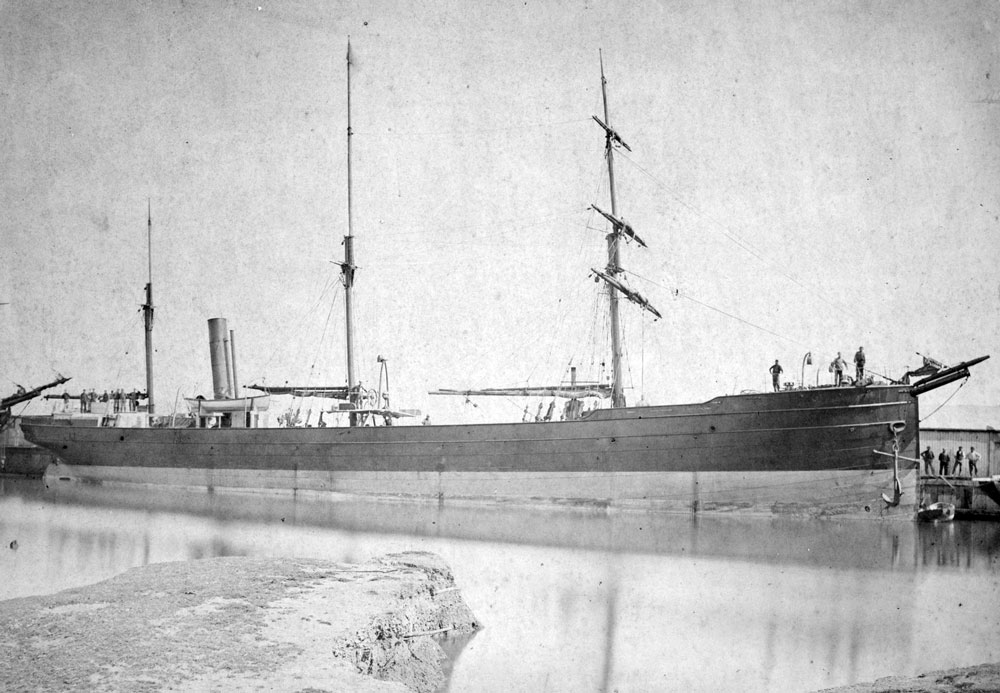 |
| SS Lady Darling |
On 8 November 1880, the SS Lady Darling left Newcastle under the command of Captain J. A. Roberts (also reported as L. A. Roberts). The weather was fine as she headed south past Sydney and on 10 November 1880 the SS Lady Darling the ship had passed Narooma on the South Coast. Captain Roberts was intending to pass between Montague Island and the mainland. The island is about six and a half kilometres from the closest part of the coast and it is said that Captain Roberts was about half way between the island and mainland as he passed the island. About here (11:20 pm) he handed over control of the ship to the Chief Officer, R. Hughes. It appears that he advised Arthur Sweet on the helm to turn a bit to the east to clear Bermagui well to the south.
South of Montague Island there are two shallow reefs. The largest of these is Aughinish Rock which is about 2.5 kilometres south-west of the southern end of the island. A further two kilometres south there is another reef. Both of these reefs break in any sort of swell and are shallow enough to wreck any large boat that crosses over the reefs. The Lady Darling drew about 16 feet 5 inches (five metres) and in even a two metre swell she was likely to hit a reef that was shallower than 7 to 8 metres at low tide.
As indicated, Chief Officer Hughes must have changed course from south to south-east or south-south-east. At about midnight the SS Lady Darling hit a reef on her port side, near the engine room. Chief Engineer Michael Kelly reported that water was pouring into the engine room. On examination, a hole the size of a garbage can lid and about 2.5 metres under the waterline was found. The pumps were put into operation but it was obvious that the ship was doomed. Captain Roberts (back on the Bridge) ordered that the ship be steered towards shore. Five minutes after hitting the reef, the water in the engine room was almost into the boiler so Kelly released steam and the engine lost power (as well as the pumps). The lifeboats were launched but the Captain did not order the immediate evacuation of the ship. Captain Roberts ordered the ship to be abandoned and at 12:30 am, he and the crew watched from a lifeboat as the ship disappeared stern first.
The crew rowed the lifeboat to Montague Island where they new there were men constructing the new lighthouse. They arrived there at 4 am. At about 5 am, the SS Kameruka sighted the masts of a sunken ship south-west of Montague Island. They examined the wreck and sounded the depth as being 15 fathoms (28 metres). The Kameruka continued to Tathra where the skipper reported their find to the authorities in Sydney.
The SS Kiama also came across the wreck that morning and later they saw signals from Montague Island. Captain Roberts rowed out to the Kiama and asked them to pass on information about the sinking to Sydney. The famous pilot steamer Captain Cook was sent from Sydney and when they arrived (12 November?), they collected the crew and went to examine the wreck. The crew were taken back to Sydney and they travelled to Melbourne on the SS Barrabool (see SS Bonnie Dundee Page for more information on this ship).
Captain Roberts later reported that the ship hit something about 3 kilometres south of Montague Island, so this makes it very likely that the ship hit Aughinish Rock rather than the other reef. Note that later the same day, the bushranger Ned Kelly was hung in Melbourne!
The Court of Marine Inquiry began on 21 November 1880 where it heard that the ship never came closer than one mile to Montague Island. The Court found that no blame could be found in the Captain or crew as the ship appeared to have hit an uncharted reef.
The SS Lady Darling lay unfound until August 1996 when the net from a Bermagui fishing trawler became entangled on something off Cape Dromedary. The skipper of the trawler, Dom Puglise, approached Bert Elswyk, the operator of a local fishing and diving charter boat, to recover his valuable net. He also told them that a piece of rivetted plate had come up with the net that he had retrieved. On 16 August 1996, Bert and local dentist, Paul Mood, went out with the aim of recovering the net and gear.
Imagine the surprise that awaited Bert and Paul when they descended to the sea floor! The net was not caught on a reef, but hooked over the remains of a shipwreck.
Located 5.5 kilometres south-west of Aughinish Rock, 8 kilometres south-west of the southern end of Monntague Island and 2 kilometres off Cape Dromedery, they had found the wreck of the SS Lady Darling. The ship is located at 36° 19' 06"S 150° 10' 06"E (note that all my GPS Readings are using AUS66 - if you use any other datum, you will need to convert the reading - see my GPS Page for more details). Note that you cannot dive this wreck without a permit from the NSW Department of Heritage. The only permits that have been ever issued are to charter boats.
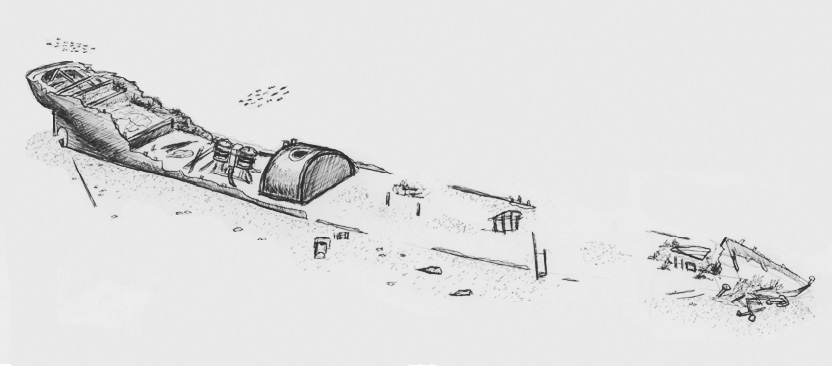 |
A drawing done by John Riley of the wreck
John Riley Memorial Collection, Heritage Branch, OEH |
When the wreck was found and the permit system implemented, I was invited by the State's Maritime Archaeologist to apply for a permit to dive the wreck from my boat. Despite offering to submit to any conditions (eg phoning the Narooma Police and asking them to search the boat for any wreck relics), I was refused a permit. Even after complaints to the Minister and the Ombudsman about discrimination, I was refused a permit. I was told that I could use the permit of the commercial operators but of the (then) seven licensees, only one replied to my letters and he said that he was not permitted to loan the permit.
After complaining to the Department that operators either ignored or told me that they could not let me use their permit, they wrote to all licensees. I then applied to them again and of the seven, only two responded (from memory). One told me that he would not let me use the permit and the other said that it could be used if we paid him $25 per person on the boat (I think) and if he or his crewman came on our boat with us. This was not acceptable to us as it would make the dive prohibitively expensive and would have cost a spot on the boat for one of our friends. It is about time the Department reviewed this policy and issued permits on a one-off basis to private boats who agree to strict conditions.
One of the conditions of the permit system is that anchoring is not permitted on the wreck. A complicated mooring system was implemented where two buoys rose from mooring blocks set off the wreck with a line stretched in between. The resulting system looks like a H shaped goal post. The permit holders drop their anchor to a designated depth and hook onto the cross-bar of the goal post. However, this system has its faults, principally that the wind must be from the right direction to work properly and the moorings and line are too light for the boats from Narooma. As of October 2001 the system is broken and cannot be used. A far simpler system of two heavier moorings with lines right to the surface (and the wreck marked on charts so boats stay clear and do not foul the lines) would work better.
The wreck lies at a depth of about 30 metres on a sandy bottom. The wreck is facing south, with the bow section separated from the main stern section. Starting from the stern a description is as follows.
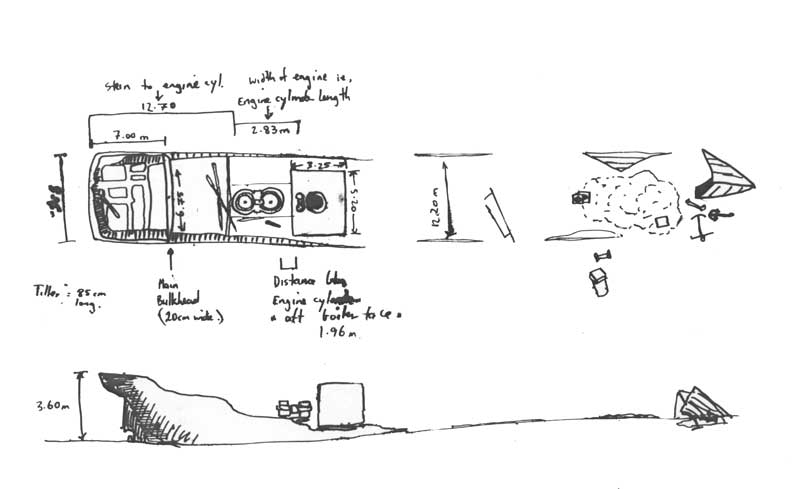 | 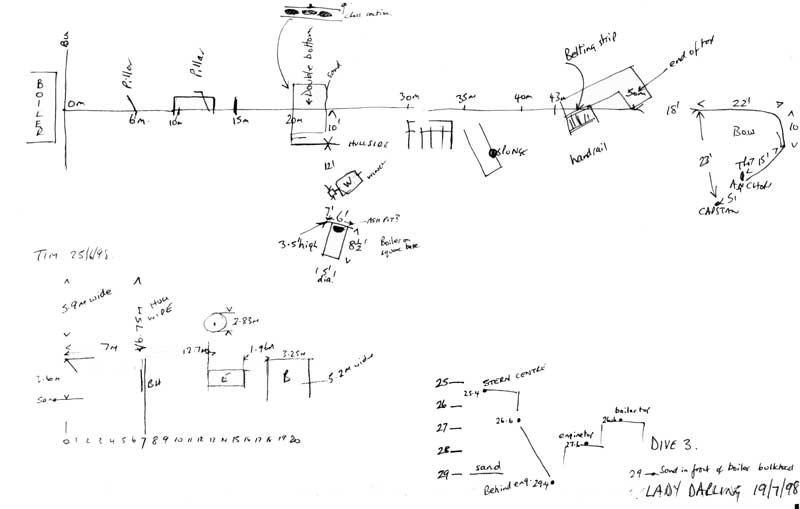 |
A diagram of the SS Lady Darling by John Riley
John Riley Memorial Collection, Heritage Branch, OEH
Click on diagram to see larger sized version | Another version of the Lady Darling diagram by John Riley
John Riley Memorial Collection - Heritage Branch, OEH
Click on diagram to see larger sized version |
The stern rises about four or five metres off the sand. One blade of the prop is visible under the stern. The rudder is not in place, probably having fallen off as the ship sank. A huge winch dominates the stern deck and there is still metal decking in this area. From memory there are a couple of decks. In front of this area is the engine, sitting upright, its two cylinders very prominent. The driveshaft can be seen running to the stern. The huge boiler is located further south of the engine. Only about half the boiler can be seen, the bottom half is buried under the sand. The sides of the ship protrude a metre or two from the sand.
This whole section of wreck is completely covered in fixed marine life, sponges, jewel anemones, yellow commensal zoanthids, sea squirts of all colours, gorgonias and giant jelly ascidians cover every square millimetre of the ship. The fishlife has to be seen to be believed. The wreck of the SS Tuggerah in Sydney has the most prolific fishlife of any wreck I have ever seen but the Lady Darling is even more spectacular, with many more species than the Tuggerah. Fish seen include yellowtail, silver sweep, mado, bullseyes, nannygais, leatherjackets of many species, striped morwong and other species. I even saw a few butterflyfish on the wreck in October! There are also huge bailer shells, at least six on the dive I did there.
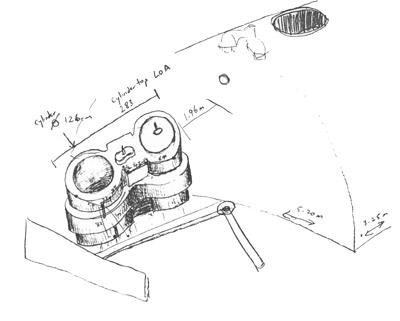 | 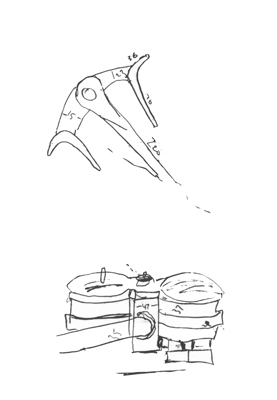 |
A diagram of the engine of the SS Lady Darling by John Riley
John Riley Memorial Collection, Heritage Branch, OEH | Some other drawings of the Lady Darling diagram by John Riley
John Riley Memorial Collection - Heritage Branch, OEH |
If you look south from the boiler you see sand. About 20 metres across you encounter the first pieces of the bow section. At first you only see bits of hull and other pieces protruding from the sand but enventually, larger pieces are visible. The bow itself is fairly intact, tilted to the starboard. The anchor is here (two?) and back closer to the stern on the starboard side are some larger bits, including the donkey boiler. The growth and fishlife is still great, but not as prolific as the stern.
This is a magnificient wreck, perhaps the best or second best in New South Wales. There is no doubt that a permit system is needed, but a more enlightened attitude to private boats is required by the NSW Government. There were originally six or seven licences to dive the wreck but now (Aug 2003) there are only two operators. You can dive the wreck with the Narooma or Bermagui charter operators. At last checking, the Narooma operators were charging exorbitant rates to dive the wreck.
References:
| 
 v6.00.307 © 2003-2005
v6.00.307 © 2003-2005